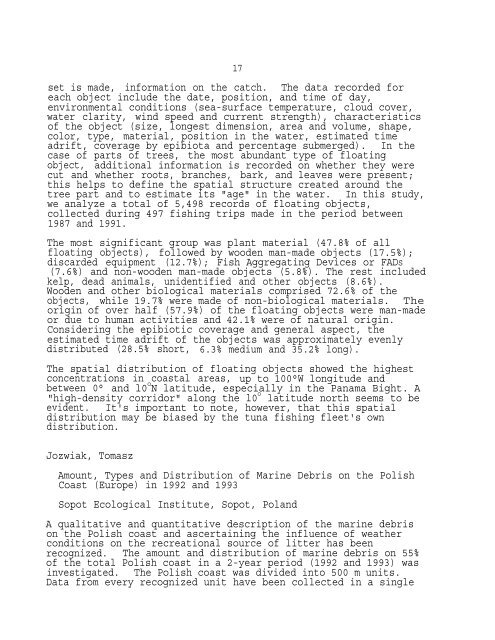Poster abstracts and manuscripts from the Third International ...
Poster abstracts and manuscripts from the Third International ...
Poster abstracts and manuscripts from the Third International ...
You also want an ePaper? Increase the reach of your titles
YUMPU automatically turns print PDFs into web optimized ePapers that Google loves.
17<br />
set is made, information on <strong>the</strong> catch. The data recorded for<br />
each object include <strong>the</strong> date, position, <strong>and</strong> time of day,<br />
environmental conditions (sea-surface temperature, cloud cover,<br />
water clarity, wind speed <strong>and</strong> current strength), characteristics<br />
of <strong>the</strong> object (size, longest dimension, area <strong>and</strong> volume, shape,<br />
color, type, material, position in <strong>the</strong> water, estimated time<br />
adrift, coverage by epibiota <strong>and</strong> percentage submerged). In <strong>the</strong><br />
case of parts of trees, <strong>the</strong> most abundant type of floating<br />
object, additional information is recorded on whe<strong>the</strong>r <strong>the</strong>y were<br />
cut <strong>and</strong> whe<strong>the</strong>r roots, branches, bark, <strong>and</strong> leaves were present;<br />
this helps to define <strong>the</strong> spatial structure created around <strong>the</strong><br />
tree part <strong>and</strong> to estimate its "age" in <strong>the</strong> water. In this study,<br />
we analyze a total of 5,498 records of floating objects,<br />
collected during 497 fishing trips made in <strong>the</strong> period between<br />
1987 <strong>and</strong> 1991.<br />
The most significant group was plant material (47.8% of all<br />
floating objects), followed by wooden man-made objects (17.5%);<br />
discarded equipment (12.7%); Fish Aggregating Devices or FADS<br />
(7.6%) <strong>and</strong> non-wooden man-made objects (5.8%). The rest included<br />
kelp, dead animals, unidentified <strong>and</strong> o<strong>the</strong>r objects (8.6%).<br />
Wooden <strong>and</strong> o<strong>the</strong>r biological materials comprised 72.6% of <strong>the</strong><br />
objects, while 19.7% were made of non-biological materials. The<br />
origin of over half (57.9%) of <strong>the</strong> floating objects were man-made<br />
or due to human activities <strong>and</strong> 42.1% were of natural origin.<br />
Considering <strong>the</strong> epibiotic coverage <strong>and</strong> general aspect, <strong>the</strong><br />
estimated time adrift of <strong>the</strong> objects was approximately evenly<br />
distributed (28.5% short, 6.3% medium <strong>and</strong> 35.2% long).<br />
The spatial distribution of floating objects showed <strong>the</strong> highest<br />
concentrations in coastal areas, up to 100°W longitude <strong>and</strong><br />
between 0° <strong>and</strong> l0 o N latitude, especially in <strong>the</strong> Panama Bight. A<br />
"high-density corridor" along <strong>the</strong> l0 o latitude north seems to be<br />
evident. It's important to note, however, that this spatial<br />
distribution may be biased by <strong>the</strong> tuna fishing fleet's own<br />
distribution.<br />
Jozwiak, Tomasz<br />
Amount, Types <strong>and</strong> Distribution of Marine Debris on <strong>the</strong> Polish<br />
Coast (Europe) in 1992 <strong>and</strong> 1993<br />
Sopot Ecological Institute, Sopot, Pol<strong>and</strong><br />
A qualitative <strong>and</strong> quantitative description of <strong>the</strong> marine debris<br />
on <strong>the</strong> Polish coast <strong>and</strong> ascertaining <strong>the</strong> influence of wea<strong>the</strong>r<br />
conditions on <strong>the</strong> recreational source of litter has been<br />
recognized. The amount <strong>and</strong> distribution of marine debris on 55%<br />
of <strong>the</strong> total Polish coast in a 2-year period (1992 <strong>and</strong> 1993) was<br />
investigated. The Polish coast was divided into 500 m units.<br />
Data <strong>from</strong> every recognized unit have been collected in a single
















